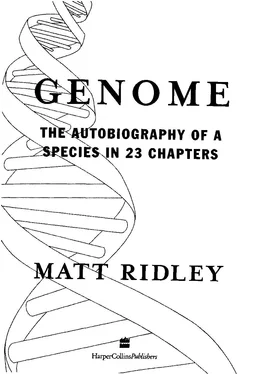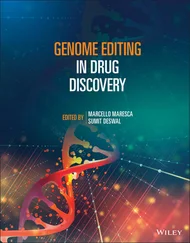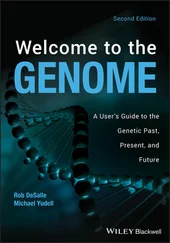Genome - Matt Ridley
Здесь есть возможность читать онлайн «Genome - Matt Ridley» весь текст электронной книги совершенно бесплатно (целиком полную версию без сокращений). В некоторых случаях можно слушать аудио, скачать через торрент в формате fb2 и присутствует краткое содержание. Жанр: Старинная литература, на английском языке. Описание произведения, (предисловие) а так же отзывы посетителей доступны на портале библиотеки ЛибКат.
- Название:Matt Ridley
- Автор:
- Жанр:
- Год:неизвестен
- ISBN:нет данных
- Рейтинг книги:5 / 5. Голосов: 1
-
Избранное:Добавить в избранное
- Отзывы:
-
Ваша оценка:
- 100
- 1
- 2
- 3
- 4
- 5
Matt Ridley: краткое содержание, описание и аннотация
Предлагаем к чтению аннотацию, описание, краткое содержание или предисловие (зависит от того, что написал сам автор книги «Matt Ridley»). Если вы не нашли необходимую информацию о книге — напишите в комментариях, мы постараемся отыскать её.
Matt Ridley — читать онлайн бесплатно полную книгу (весь текст) целиком
Ниже представлен текст книги, разбитый по страницам. Система сохранения места последней прочитанной страницы, позволяет с удобством читать онлайн бесплатно книгу «Matt Ridley», без необходимости каждый раз заново искать на чём Вы остановились. Поставьте закладку, и сможете в любой момент перейти на страницу, на которой закончили чтение.
Интервал:
Закладка:
extreme. Wild predictions of millions of deaths in Britain alone were taken seriously. The folly of turning cattle into cannibals was widely portrayed as an argument for organic farming. Conspiracy theories abounded: that the disease was caused by pesticides; that scientists were being muzzled by politicians; that the true facts were being suppressed; that deregulation of the feed industry had caused the problem; that France, Ireland, Germany and other countries were suppressing news of epidemics just as large.
The government felt obliged to respond with a further useless ban, on the consumption of any cow over thirty months of age: a ban that further inflamed public alarm, ruined a whole industry and choked the system with doomed cattle. Later that year, at the insistence of European politicians, the government ordered the 'selective cull' of 100,000 more cattle, even though it knew this was a meaningless gesture that would further alienate farmers and consumers. It was no longer even shutting the stable door after the horse had bolted; it was sacrificing a goat outside the stable. Predictably, the 2 8 4 G E N O M E
new cull did not even have the effect of lifting the European Union's largely self-interested ban on all British beef exports. But worse was to follow with the ban on beef on the bone in 1997. Everybody agreed that the risk from beef on the bone was infinitesimal - likely to lead to at most one case of C J D every four years. The government's approach to risk was now so nationalising that the agriculture minister was not even prepared to let people make up their own minds about a risk smaller than that of being struck by lightning.
By taking such an absurd attitude to risk, indeed, the government predictably provoked riskier behaviour in its subjects. In some circles, almost a mood of civil disobedience obtained, and I found myself offered more oxtail stew as the ban loomed than I had ever done before.
Throughout 1996, Britain braced itself for an epidemic of human B S E . Yet in the year from March only six people died of the disease.
Far from growing, the numbers seemed to be steady or falling. As I write, it is still uncertain how many people will die of 'new-variant'
C J D . The figure has inched up past forty, each case an almost unimaginable family tragedy, but not yet an epidemic. At first, the victims of this new-variant C J D appeared, on investigation, to be particularly enthusiastic meat-eaters in the dangerous years, even though one of the first cases had turned vegetarian some years before. But this was an illusion: when scientists asked the relatives of those thought to have died of C J D (but who, post mortem, were proved to have died of something else) about their habits, they found the same meat-eating bias: the memories said more about the psychology of the relatives than reality.
The one thing the victims had in common was that almost all were of one genotype-homozygous for methionine at 'word' 129.
Perhaps the far more numerous heterozygotes and valine¬
homozygotes will prove simply to have a longer incubation period: B S E transmitted to monkeys by intracerebral injection has a much longer incubation period than most prion diseases. On the other hand, given that the vast majority of human infections from beef would have occurred before the end of 1988, and ten years is already P O L I T I C S 2 8 5
twice as long as the average incubation period in cattle, maybe the species barrier is as high as it seems in animal experiments and we have already seen the worst of the epidemic. Maybe, too, the new-variant C J D has nothing to do with beef-eating. Many now believe that the possibility that human vaccines and other medical products, made with beef products, posed a much greater danger was somewhat too hastily rejected by the authorities in the late 1980s.
C J D has killed lifelong vegetarians who had never had surgery, never left Britain and never worked on a farm or in a butcher's shop. The last and greatest mystery of the prion is that even today
- when forms of C J D have been caught by all sorts of known means, including cannibalism, surgery, hormone injections and possibly beef-eating - eighty-five per cent of all C J D cases are 'sporadic', meaning that they cannot at the moment be explained by anything other than random chance. This offends our natural determinism, in which diseases must have causes, but we do not live in a fully determined world. Perhaps C J D just happens spontaneously at the rate of about one case per million people.
Prions have humbled us with our ignorance. We did not suspect that there was a form of self-replication that did not use D N A -
did not indeed use digital information at all. We did not imagine that a disease of such profound mystery could emerge from such unlikely quarters and prove so deadly. We still do not quite see how changes in the folding of a peptide chain can cause such havoc, or how tiny changes in the composition of the chain can have such complicated implications. As two prion experts have written, 'Personal and family tragedies, ethnological catastrophes and economic disasters can all be traced back to the mischievous misfolding of one small molecule.'
C H R O M O S O M E 2 1
E u g e n i c s
I know no safe depository of the ultimate powers of the society but the people themselves, and if we think them not enlightened enough to exercise that control with a wholesome discretion, the remedy is not to take it from them, but to inform their discretion. Thomas Jefferson Chromosome 21 is the smallest human chromosome. It ought, as a result, to be called chromosome 22, but the chromosome that has that name was until recently thought to be smaller still and the name is now established. Perhaps because it is the smallest chromosome, with probably the fewest genes, chromosome 21 is the only chromosome that can be present in three copies rather than two in a healthy human body. In all other cases, having an extra copy of a whole chromosome so upsets the balance of the human genome that the body cannot properly develop at all. Children are occasionally born with an extra chromosome 13 or 18, but they never survive more than a few days. Children born with an extra chromosome 21 are healthy, conspicuously happy and destined to live for many years.
But they are not considered, in that pejorative word, 'normal'. They E U G E N I C S 287
have Down syndrome. Their characteristic appearance — short stature, plump bodies, narrow eyes, happy faces - is immediately familiar. So is the fact that they are mentally retarded, gentle and destined to age rapidly, often developing a form of Alzheimer's disease, and die before they reach the age of forty.
Down-syndrome babies are generally born to older mothers. The probability of having a Down-syndrome baby grows rapidly and exponentially as the age of the mother increases, from 1 in 2,300 at the age of twenty to 1 in 100 at forty. It is for this reason alone that Down embryos are the principal victims, or their mothers the principal users, of genetic screening. In most countries amniocentesis is now offered to - perhaps even imposed on - all older mothers, to check whether the foetus carries an extra chromosome. If it does, the mother is offered - or cajoled into - an abortion. The reason given is that, despite the happy demeanour of these children, most people would rather not be the parent of a Down child. If you are of one opinion, you see this as a manifestation of benign science, miraculously preventing the birth of cruelly incapacitated people at no suffering. If you are of another opinion you see the officially encouraged murder of a sacred human life in the dubious name of human perfection and to the disrespect of disability. You see, in effect, eugenics still in action, more than fifty years after it was grotesquely discredited by Nazi atrocities.
Читать дальшеИнтервал:
Закладка:
Похожие книги на «Matt Ridley»
Представляем Вашему вниманию похожие книги на «Matt Ridley» списком для выбора. Мы отобрали схожую по названию и смыслу литературу в надежде предоставить читателям больше вариантов отыскать новые, интересные, ещё непрочитанные произведения.
Обсуждение, отзывы о книге «Matt Ridley» и просто собственные мнения читателей. Оставьте ваши комментарии, напишите, что Вы думаете о произведении, его смысле или главных героях. Укажите что конкретно понравилось, а что нет, и почему Вы так считаете.












